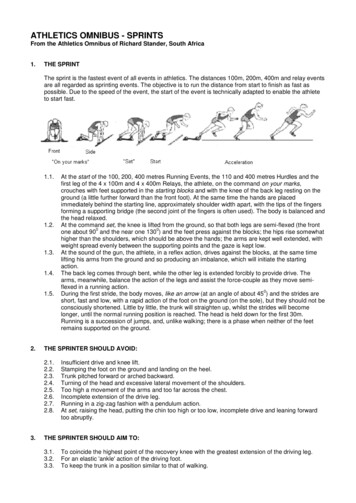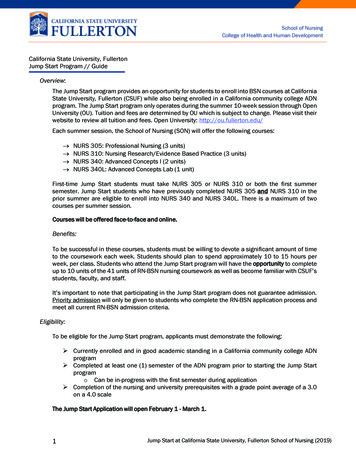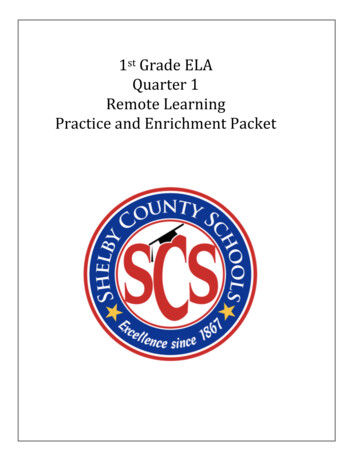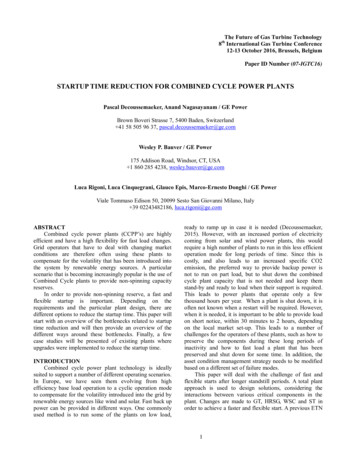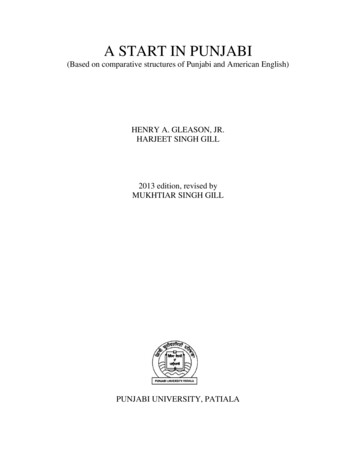
Transcription
A START IN PUNJABI(Based on comparative structures of Punjabi and American English)HENRY A. GLEASON, JR.HARJEET SINGH GILL2013 edition, revised byMUKHTIAR SINGH GILLPUNJABI UNIVERSITY, PATIALA
A START IN PUNJABIbyHenry A. Gleason, jr.Harjeet Singh Gill2013 edition, revised byMUKHTIAR SINGH GILLThe Advanced Centre for the Technical Development of Punjabi Language,Literature and Culture.Punjabi University Patiala.
PREFACEA START IN PUNJABI is based on detailed analyses of soundpatterns and syntactic structures of Punjabi and American English. Itmay be used alongwith its companion volume, A REFERENCEGRAMMAR OF PUNJABI, where the authors have dwelt uponcolloquial as well as cultivated expressions collated fromcontemporary literature. There is also a chapter on the Gurumukhiwriting system. This book was first circulated in the United States inmimeograph form in Hartford Studies in Linguistics, 1963.Harjeet Singh GillPunjabi University, Patiala, 1970.The 2013 edition is annotated and revised by Mukhtiar Singh Gill,Project Associate, with the active participation of Professor GurpreetSingh Lehal, Director of the Advanced Centre for the TechnicalDevelopment of Punjabi Language, Literature and Culture, PunjabiUniversity, Patiala.Harjeet Singh GillProfessor of EminencePunjabi University, Patiala, 2013.
CONTENTSLesson one: Introduction – unaspiratedconsonants – high tone. 1Lesson two: Welcome Home – vowels. 10Lesson three: Welcome Home – consonants(k c t p / g j d b), r. 17Lesson four: Dining – consonants(k c t p / kh ch th ph),Punjabi and English v/w. 23Lesson five: Fruit Market – single anddouble consonants,Punjabi and English a/ā,present/ future. 32Lesson six: Sweets shop – retroflexsounds, Punjabi and Englishr/ḍ/ṛ, feminine/ masculine, counting. 38Lesson seven: Market – tones, counting. 45Lesson eight: Directions, hiringa rickshaw-ṛ/ḍ/ṭ/ṇ,tones, infinitive, present,future, counting in fractions. 50Lesson nine: Fruit Market-retroflexlateral,ḷ/ḍ , singular/plural,feminine/ masculine,positive/ negative. 58Lesson ten: Golden Temple Amritsar –tones,narrative, present continuous. 63
Lesson eleven: A Folk-Tale (of a crow andsparrow) - summary of consonantsand vowels, ph/f, j/z,nasals, tones on differentsyllables, narrative past tense. 69Lesson twelve: A Legend (Guru Nanak andMardana) - narrative, differentforms of past tense,instrumental constructions, case forms. 77Lesson thirteen: Diwali (the festival oflights) – the sentencestructure, narrative presenttense, forms of the auxiliary. 83Lesson fourteen : Id (an important Muslimfestival) – narrative presenttense, verb phrases. 88Lesson fifteen: Lohri (the winter festival offire) – future tense, past tense. 97Lesson sixteen: Agriculture – use of what,where, who, why, emphatic,negative, other forms of questions. 105Lesson seventeen : On the Farm – generaldialogue, imperatives, pronouns. 112Lesson eighteen : Around the kitchen invillage – present, past, futurecommands, requests, suggestions,subordinate clauses. 119Lesson nineteen : Vegetable Market – emphatics,intonation.129Lesson twenty 138: Suggestions for further study.
LESSON ONEDIALOGUES1.1Dialogues in Gurmukhiਮੋਹਣ ਿਸੰਘਸਿਤ ਸਰ੍ ਅਕਾਲ।ਸੋਹਣ ਿਸੰਘਸਿਤ ਸਰ੍ ਅਕਾਲ।ਮੋਹਣ ਿਸੰਘਕੀ ਹਾਲ ਏ?ਸੋਹਣ ਿਸੰਘਅੱਛਾ, ਤੁ ਸ ਸੁਣਾਓ।ਮੋਹਣ �ਮ ਲਾਲਮੋਤੀਰਾਮ ਲਾਲਮੋਤੀਰਾਮ �ੇ।ਚਾਹ ਪੀਓਗੇ?ਨਹ , ਕੋਈ ਤਕਲੀਫ ਨਾ ਕਰੋ।ਨਹ , ਕੋਈ ਤਕਲੀਫ ਨਹ ।ਅੱਛਾ, �ਾਮ।ਸਲਾਮ। ਆਓ, ਏਧਰ ਆਓ। ਿਕਵ ਆਏ?ਏਵ , ਿਮਲਣ ਵਾਸਤੇ।ਚਾਹ ਪੀਓਗੇ ?ਅੱਛਾ।ਦੀਨਬੇਗਦੀਨ1
1.1Transcription of above Dialoguesmóṇ sıǵ ̃sat sirī akāl.sóṇ sıǵ ̃sat sirī akāl.móṇ sıǵ ̃kī hāl e?sóṇ sıǵ ̃aččhā, tusī̃ suṇāo.móṇ sıǵ ̃mérbānī.1.21.3rām lālmotīrām lālmotīrām lālmotīnamaste.namaste.čā́ pīoge?naī̃,́ koī taklīf nā karo.naī̃,́ koī taklīf naī́.aččhā, mérbānī.dīnbegsalām.salām. āo, édar āo. kiwẽāe?ewẽ, milṇ wāste.čā́ pīoge ?aččhā.dīnbegdīn1.1Translation of above DialoguesMohan Singh /sat sirī akāl./Sohan Singh/sat sirī akāl./Mohan Singh How are you ?Sohan SinghFine. How about you?Mohan Singh Fine, thank you2
1.2Ram LalMotiRam LalMotiRam LalMoti/namaste.//namaste./Will you have some tea?No thanks. Don’t bother.It’s no trouble.O.K., thanks.DinBeg/salām.//salām./ Come in. Whatbrings you here?Just to see you.Have some tea?All right.1.3DinBegDinUSAGE NOTES1.4/sat sirī akāl./ is the usual greeting between Sikhs. /namaste./ is usualgreeting between Hindus. /salām. / is a usual and informal greetingbetween Muslims or Christians. If you are observant, you will soonlearn which is appropriate under any set of circumstances. Theremainder of each of the three opening dialogues above can be usedwith any of the three opening formulas. For example, you might startwith /namaste/ and continue with /kī hāl e?/. After practicing thedialogues just as they are given try making these re-combinations.1.5Dialogue 1.1 is a typical brief interchange as two people meet. It canbe used in almost any place or in almost any situation. 1.2 and 1.3 aretypical greetings as one person comes to visit another in his home. 1.3might be used even if the visitor comes for some serious business.Etiquette demands that the business should not be brought up untilafter some exchange of pleasantries. All of these, of course, are short.Frequently longer interchanges will be used.3
1.6Your instructor will demonstrate for you the gestures whichcommonly accompany these greetings. They are part of the totaldialogue, and should be practiced alongwith the words.The gestures in use in Punjab differ in many ways fromthose in use in America. It is very nearly as important to learn to useand understand the gestures as it is to learn the vocal language. Makea habit of watching your instructor as he speaks and imitate him.1.7If you do not hear or understand something, you may sayਤੁ ਸ ਕੀ ਿਕਹਾ?tusī̃ kī kiā́ ?or for short, just :ਕੀ ਿਕਹਾ?kī kiā́ ?or even:ਕੀ?kī?In such a situation, all of these would mean something like ‘What didyou say ? The longer form is, of course, more formal.PRONUNCIATION1.8The Punjabi sound we transcribe as /t/ is quite different from theEnglish ‘t’. This difference can be easily heard by comparing somePunjabi words with some roughly similar English words. Yourinstructor will pronounce the following Punjabi words for you. Onemember of the class should pronounce after each Punjabi word theEnglish word in the pair. Listen carefully for the difference betweenPunjabi /t/ and English ‘t’. There will, of course, be differences inother parts of the words too, but in this lesson you concentrate on thecorrect pronunciation of /t/. Do the best you can with the otherfeatures by imitation, but do not worry about the detail just now.4
Gurmukhi ord‘tin’‘toll’‘meat’Gurmukhi d‘ton’‘neat’‘seat’The differences between /t/ and ‘t’ are mainly two :English ‘t’ is formed by touching the tip of the tongueto the gums just above and behind the front teeth. Punjabi /t/ is formedby touching the tip of the tongue to the back of the teeth. Punjabi /t/ issaid to be dental. In the dialogues and drills, be careful to make yourtongue actually touch the teeth rather than the gums. At first it willtake a little extra conscious effort to force the tongue farther forward.With practice, this will become easy and automatic.In English ‘t’ the moment the tongue is pulled away from thegums, a little puff of breath is generally emitted. This occurs in wordswith initial ‘t’, but not in words with initial ‘st.’ This difference can bedemonstrated by holding a narrow strip of paper in front of the lips.When a word like ‘till’ is said, the strip suddenly moves forward.When a word like ‘still’ is said, it does not. (It may take a littleexperimenting to get a strip of paper of just the right degree offlexibility to show the difference clearly.) The ‘t’ in ‘till’ is said to beaspirated. Punjabi /t/ is always unaspirated. It may be helpful topractice with a paper strip, and perhaps a mirror to watch it carefully.1.9Your instructor will pronounce the following words for you as amodel. Imitate him in every detail, concentrating especially on /t/. Besure to pronounce it dental and ਬਾਤਤੂ ��ਾਪਜੋਤI.P.Atortīrpotātāpjot
Meanings are not given for these words, as they are not to be learnednow, They are given solely for pronunciation practice.1.10Punjabi ‘p’ and ‘k’ differ little from English ‘p’ and ‘k’ in theposition of the tongue or lips. However, both are unaspirated,whereas English ‘p’ and ‘k’ are generally aspirated, except in ‘sp’ and‘sk’. Try the paper-strip test on ‘pin’, ‘spin’, ‘kin’, and ‘skin’. Thetest shows the difference most clearly with ‘p’, because the explosionis near the paper. The difference is just as important with ‘k’ even ifharder to see.Compare your instructor’s pronunciation of the followingPunjabi words with that of one of the class member’s as he reads thepaired English words.Gurmukhi ��calm’Practice the following words, imitating your instructor’spronunciation. If you have difficulty with aspiration, it may behelpful to practice with a paper strip and a ਲਤੋਪਕਲਹਕੂ ਰਕਮਕੂ ਚI.P.Apalnāpčūppāltopkálkūrkamkūč
ਕਤਲੋ ਕkatlokSome of the words in the dialogue have normal tone and some havehigh. Normal tone is not marked in the transcription. High tone ismarked with an accent / /. A word bearing high tone has a higherpitch than the one with a normal tone. It will require a great deal ofpractice before you can hear and reproduce this difference accuratelyand easily. At this stage, the best thing to do is to practice thesentences of the dialogue as whole sentences, paying special attentionto the “tone” of the sentence as a whole, and to its rhythm.One word sentences (that is, words said by themselves)are not very usual, but the tone differences stand out clearly. Thefollowing pairs show the contrast between normal and high tone.Practice them, imitating your instructor.Gurmukhi �ੀਹਲੋ �lā́bā́ rā́ rmā́ lwā́ rkā́ lpī́lómórmórīkā́ �‘single-fold’Do not learn the meanings of these words at this time. The meaningsare given just to show that a difference in tone, slight as it may seemto you at first, can change the meaning of a Punjabi word drastically.It is crucial that you learn to recognize and reproduce tones7
accurately, as otherwise you will not be understood, or, worse, youmay be misunderstood.1.13A Punjabi sentence is said with an intonation, a pattern of pitch,prominence, and rhythm. This is an important feature of the spokenlanguage. The intonation helps to mark off the flow of speech intoportions such as sentences. Different intonations help to markdifferent types of sentences. In the dialogues, some of the sentencesare clearly distinguished by having different intonations than others.The most obvious intonational difference in these lessons is thatbetween questions and answers. Often only intonation marks thedifference.Intonation and pitch interact in Punjabi in ways that are verydifficult to describe. Fortunately, they can be learned even without aclear description. If you will practice the sentences of the dialoguescarefully until you can say each with the proper pitch, prominence,and rhythm, you will soon learn to hear the intonation and tones of thesentences. If you cannot now hear a consistent difference betweenwords marked / / and words not so marked, do not worry about it.That will come in time.1.14Throughout all your work with Punjabi, consider your instructor’spronunciation as the standard. Imitate him as accurately as you can.Do not be satisfied with your work until it sounds, both to you and tohim, just like the pronunciation of a Punjabi.The transcriptions are given primarily to point out to youcertain significant features which you must learn to hear in yourinformant's speech. Use them only as guides in listening to him and inimitating. Do not base your pronunciation on the transcriptions.1.15Sentences are much more important units of speech than are words.Try to learn to pronounce whole sentences as single continuous flowsof speech. Word divisions are shown in the transcriptions, but youmay not hear them in speech. Do not pause where they are shown. Ifyou do, your speech will sound halting or artificial.Do not worry over the meanings of single words in thedialogue sentences. That also will come later. The translations givenare intended to indicate the meanings of whole sentences. Very often8
the internal structure of the sentences is very different from that ofany English sentence.Under the head of "Pattern Practice" sentences will begiven in sets that will permit you to see internal structure. You candetermine for yourself what certain parts of these sentences mean bycomparing the sentences in one set, and noting the places where theirmeanings differ. In some cases, sentences in the Pattern Practice willparallel and explain sentences in the dialogues. Before the course isfinished, most of the sentences in the dialogues will have becomeclear to you.When sentences in the Pattern Practices do parallel those inthe dialogues; they permit you to vary the dialogues a little. Forexample, you might change dialogue 1.2 by saying /kāfī pīoge?/ins
Punjabi words with some roughly similar English words. Your instructor will pronounce the following Punjabi words for you. One member of the class should pronounce after each Punjabi word the English word in the pair. Listen carefully for the difference between Punjabi /t/ and English ‘t’. There will, of course, be differences inFile Size: 1MBPage Count: 173

